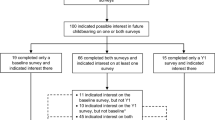Abstract
Objectives: Late age at first birth and nulliparity are established risk factors for breast cancer, yet the extent to which fertility problems contribute to these associations remains largely unexplored. Here, we examine self-reported fertility problems as a risk factor for breast cancer in young women.
Methods: We used a population-based case-control study of 2,173 cases and 1,990 controls aged 20 to 54 years in the United States. Structured in-person interviews were used to elicit detailed information on established and potential breast cancer risk factors. Information was collected on pregnancy details, including difficulties becoming pregnant or maintaining a pregnancy.
Results: Self-reported difficulty in becoming pregnant or maintaining a pregnancy was reported by 450 cases and 377 controls. Overall, there was little association between these fertility problems and risk of breast cancer (odds ratio [OR] = 1.05). Parity was associated with a decreased risk of breast cancer in women both with (OR = 0.71) and without (OR = 0.79) fertility problems. There was little evidence of an increased risk of breast cancer with later age at first full-term birth among women without fertility problems (ORage 35+ :age <20 = 1.13, 95 percent confidence interval [CI] = 0.7-1.9), but a relatively strong association among women with fertility problems (ORage 35+ :age <20 = 2.96, CI = 1.3-7.0). Among women with a first full-term birth at age 35 or older, fertility problems were associated with a twofold risk of breast cancer. Analyses of duration of unprotected sexual intercourse prior to first pregnancy as an alternative estimate of infertility produced similar results.
Conclusions: Our study suggests that the association between late age at first birth and breast cancer is stronger among women with self-reported fertility problems than among women with no fertility problems. Cancer Causes and Control 1998, 9, 331-339
Similar content being viewed by others
References
US Congress, Office of Technology Assessment. Infertility: Medical and Social Choices. Washington DC: US Government Printing Office, May 1988; OTA-BA-358.
Kelsey JL, Gammon MD, John EM. Reproductive factors and breast cancer. Epi Review 1993; 15: 36–47.
Cowan LD, Gordis L, Tonascia JA, Seegar Jones G. Breast cancer incidence in women with a history of progesterone deficiency. Am J Epidemiol 1981; 114: 209–17.
Paffenberger RS, Kampert JB, Chang HG. Characteristics that predict risk of breast cancer before and after the menopause. Am J Epidemiol 1980; 112: 258–68.
Coulam CB, Annegers JF, Kranz JS. Chronic anovulation syndrome and associated neoplasia. Obstet Gynecol 1983; 61: 403–7.
Vessey MP, McPherson K, Roberts MM, Neil A, Jones L. Fertility in relation to the risk of breast cancer. Br J Cancer 1985: 52: 625–8.
La Vecchia C, Decarli A, Parazzini F, et al. General epidemiology of breast cancer in Northern Italy. Int J Epid 16: 347–55.
Ron E, Lunenfeld B, Menczer J, et al. Cancer incidence in a cohort of infertile women. Am J Epidemiol 1987; 125: 780–90.
Brinton LA, Melton LJ III, Malkasian GD, Bond A, Hoover R. Cancer risk after evaluation for infertility. Am J Epidemiol 1989; 129: 712–22.
Le MG, Bachelot A, Hill C. Characteristics of reproductive life and risk of breast cancer in a case-control study of young nulliparous women. J Clin Epidemiol 1989; 42: 1227–33.
Gammon MD, Thompson WD. Infertility and breast cancer: a population-based case-control study. Am J Epidemiol 1990; 132: 708–16.
Sellers TA, Potter JD, Severson RK, et al. Difficulty becoming pregnant and family history as interactive risk factors for postmenopausal breast cancer: the Iowa Women's Health Study. Cancer Causes Control 1993; 4: 21–8.
Venn A, Waston L, Lumley J, Giles G, King C, Healy D. Breast and ovarian cancer incidence after infertility and in vitro fertilisation. Lancet 1995; 346: 995–1000.
Rossing MA, Daling JR, Weiss NS, Moore DE, Self SG. Risk of breast cancer in a cohort of infertile women. Gyn Oncol 1996: 60: 3–7.
Brinton LA, Daling JR, Liff J, et al. Oral contraceptives and breast cancer risk among younger women. J Natl Cancer Inst 1995; 87: 827–35.
Kahn HA, Sempros CT. Statistical Methods in Epidemiology. New York, NY (USA): Oxford University Press, 1989: 87–9.
Pike MC, Spicer DV, Dahmoush L, Press MF. Estrogens, progestogens, normal breast cell proliferation, and breast cancer risk. Epidemiol Rev 1993; 15: 17–35.
Kline J, Stein Z, Susser M. Conception to Birth: Epidemiology of Prenatal Development. New York, NY (USA): Oxford University Press, 1989: 374–6.
Hecker E, Vegh I, Levy CM, et al. Clinical trial of clomiphene in advanced breast cancer. Eur J Cancer 1974; 10: 747–9.
Author information
Authors and Affiliations
Rights and permissions
About this article
Cite this article
Weiss, H.A., Troisi, R., Rossing, M.A. et al. Fertility Problems and Breast Cancer Risk in Young Women: a Case-Control Study in the United States. Cancer Causes Control 9, 331–339 (1998). https://doi.org/10.1023/A:1008881305738
Issue Date:
DOI: https://doi.org/10.1023/A:1008881305738



